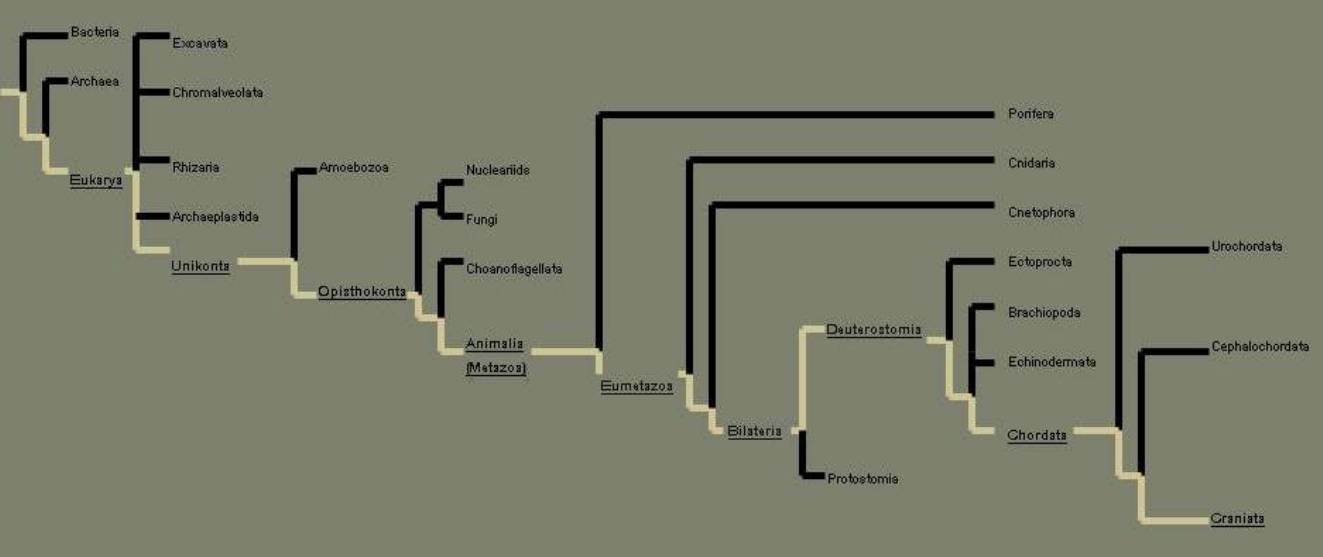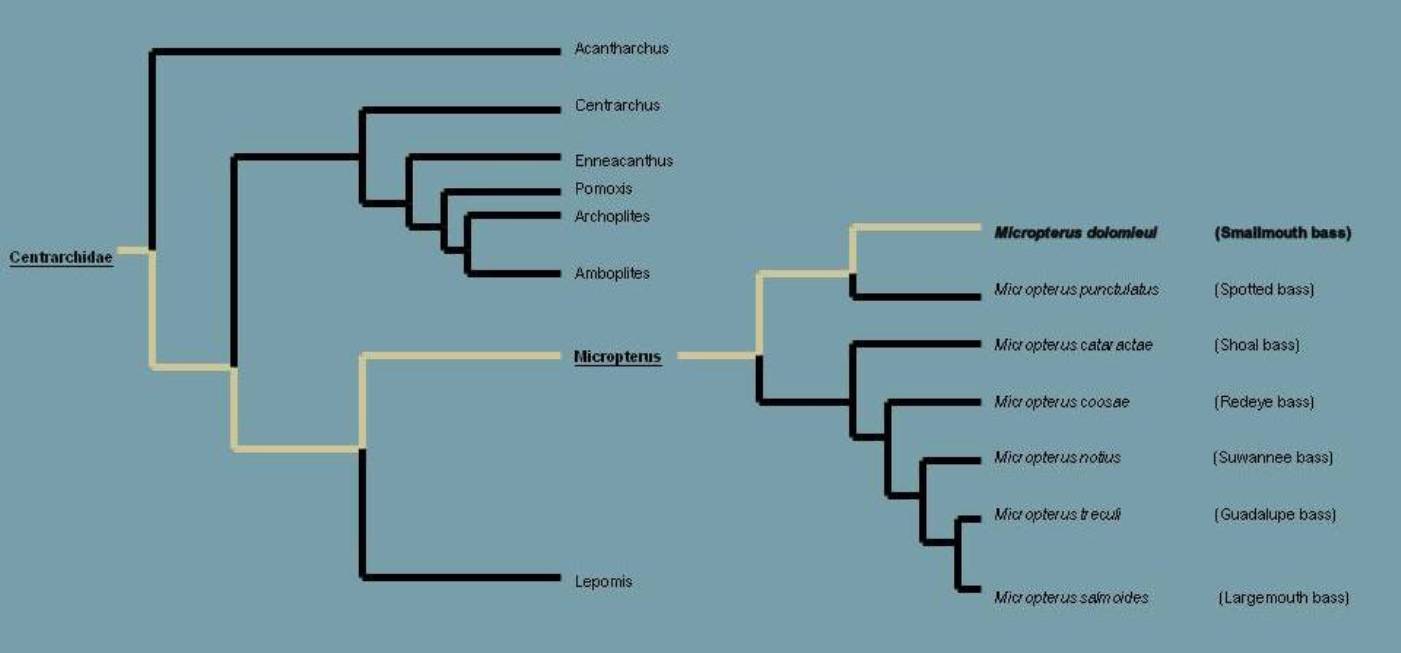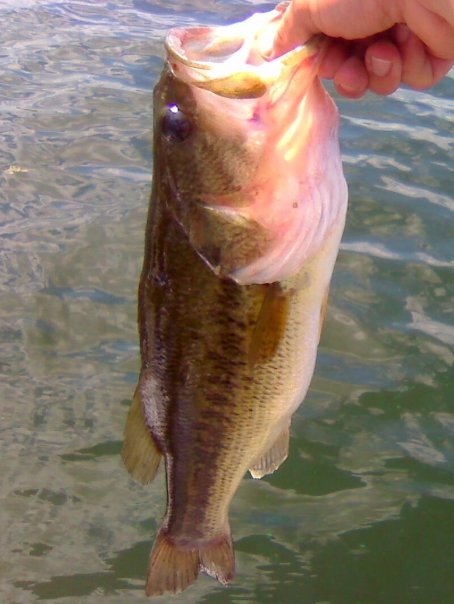SMALLMOUTH BASS
(Micropterus dolomieui)
Dustin Hetke
BIO 203: Organismal Biology, UW-La Crosse
Smallmouth systematics
TAXONOMIC CLASSIFICATION OF THE SMALLMOUTH BASS:
| Domain | Eukarya |
| Kingdom | Animalia |
| Phylum | Chordata |
| Class | Actinopterygii |
| Order | Perciformes |
| Family | Centrarchidae |
| Genus | Micropterus |
| Species | Micropterus dolomieui |
The general purpose of formally classifying an organism (systematics) is
to group it with other organisms that have similar traits, name
it appropriately (taxonomy), and establish the evolutionary
relationships that exist between it and other organisms (phylogeny).
When it comes to a fish species like the smallmouth bass, classification
goes far beyond simply listing the main taxa (as I have done above)
under which it is assigned. In fact, if only these taxonomic
ranks were included, this would be a gross underrepresentation of the
complicated and often-argued phylogenetic relationships that exist
between smallmouth bass and other organisms.
The phylogenetic tree shown below begins with the most inclusive of all
taxa (domain), then gradually becomes more exclusive as it works its way
past the animal Phyla. The evolutionary relationships that it
displays are based almost entirely upon comparative morphology. I
constructed this, along with the other two trees on this page, using
Microsoft PowerPoint. The smallmouth’s ancestral heritage can be
traced by the off-colored lines and underlined taxa. For a better
view of the phylogenetic trees on this page, please click on them and
allow them to open in a new window.
The smallmouth bass belongs to the domain Eukarya. It is a eukaryotic organism, meaning that it is comprised of cells which contain membrane-bound organelles and a nucleus that houses its linear DNA. It is also multi-cellular, motile, and hetotrophic, while its cells lack cell walls; these characteristics place the smallmouth within the kingdom Animalia. As a member of the phylum Chordata, it is comprised of three embryonic tissue layers (triploblastic); it is a coelomate, possessing a fluid-filled cavity that provides for space for a circulatory system and internal organs; it is a deuterostome, meaning that it exhibits spiral embryonic cleavage; the blastophore develops into the anus after gastrulation; and its segmented body exhibits bilateral body symmetry, which allows for the smallmouth's high degree of cephalization (well-developed head region). Along with providing other benefits, cephalization has allowed the smallmouth bass to become equipped with very specialized sensory adaptations. As a chordate, it also possesses a notochord, which eventually develops into the backbone or spine; a dorsal nerve cord, which becomes the spinal cord; pharyngeal gill slits; and a post-anal tail. The smallmouth’s brain is enclosed within a protective bony skull called a cranium, which places it within the subphylum Craniata.
The next phylogenetic tree, frankly, is a continuation of the first; it spans from subphylum to family. As you may notice, I have chosen not to include the names of every single group for purposes of preserving my sanity. Having spent hours in toil, I found that including all of the group names would be very unreasonable for the following legitimate reasons: from class to family, the exact relationships between various groups and subgroups remain largely in question and heavily debated; and there are far too names of existing taxa than would realistically fit within the confines of this illustration. Furthermore, many groups are paraphyletic, including a common ancestor and some but not all of its descendents. In a nutshell, the phylogenetic relationships shown here are not set in stone and are likely to be further refined by systematists in the near future.
Within the subphylum Craniata, the smallmouth bass is classified as a vertebrate because it has a true spinal column (backbone and vertebrae). Because it possesses jaws, unlike lampreys (class Myxini) and hagfish (Petromyzontiformes) of the infraphylum Agnatha, the smallmouth bass is grouped with other jawed fishes within the infraphylum Gnathostomata. Its endoskeleton consists of bone rather than cartilage, placing it in the super-class Osteichthyes (bony fish). Its fins are comprised of spiny rays as opposed to lobes, placing the smallmouth within the class Actinopterygii (ray-finned fishes). Within the sub-class Neopterygii, the smallmouth bass is considered a teleost (infraclass Teleostei) in light of its completely movable jaws and homocercal tail, which has symmetrical upper and lower halves. Furthermore, the spinal column of teleosts terminates at the peduncle rather than extending through the length of the upper caudal fin. Within the superorder Acanthopterygii, which means “spiny finned one,” the smallmouth bass belongs to the order Perciformes, which means “perch-like.” This is because the smallmouth has two dorsal fins, the anterior spiny and the posterior soft; pectoral fins; rough, ctenoid scales; and a tail comprised of spiny rays covered by a soft, membrane-like substance. Within the order Perciformes is the North American sunfish family (Centrarchidae), to which the smallmouth bass belongs.
The final phylogenetic tree that I have included covers the most exclusive of taxa, spanning from family to species. It is based not only on comparative morphology, but on molecular evidence. In other words, different genera of the Sunfish family, and more specifically different species within the Micropterus genus, can be distinguished from each other on the basis of their relative similarities and differences in DNA sequence. The relationships shown in this particular tree are derived from a subset of nuclear DNA genes, along with two mitochondrial genes (cytochrome b and ND2).
Within the family Centrarchidae, systematists have identified eight genera and over 30 distinct species. The smallmouth bass, along with other sunfish, is characterized by its compact, laterally-compressed body form. Nearly all sunfish are also distinguished nest-builders, with the male serving as the temporary guardian of his offspring during the spawning season. Sunfish are further identified by having between three and eight spines in their anal fins, pelvic fins in the thoracic region of their ventral surface, and ctenoid scales (see Adaptive morphology & sensation). Sunfish genera that are most common in Wisconsin include Lepomis (bluegill, pumpkinseed, etc.), Pomoxis (black crappies, white crappies), Ambloplites (rock bass), and Micropterus (smallmouth and largemouth bass). Below is a photograph of a large bluegill (Lepomis macrochirus) that I caught several years ago:
The smallmouth bass is the type species of the genus Micropterus (“small fin”), whose members are commonly called the “black basses.” This group has gained most of its notoriety from the smallmouth’s closely-related cousin, the largemouth bass, but the smallmouth is still a very popular game fish in North America. In order of their extent of distribution, the following species are recognized members of the Micropterus genus: largemouth bass (M. salmoides), smallmouth bass (M. dolomieui), spotted bass (M. punctulatus), redeye bass (M. coosae), shoal bass (M. cataractae), Suwannee bass (M. notius) and Guadalupe bass (M. treculi). Depending on who you ask, there are either two subspecies or two distinct species of largemouth bass, one being the northern strain (M. salmoides salmoides) and one being the Florida largemouth (M. salmoides floridanus), which grows faster in the southern climate and attains much greater size. There are also two subspecies of smallmouth bass, those being the northern strain (M. dolomieui dolomieui), which is found here in Wisconsin, and the endangered Neosho strain from Missouri (M. dolomieui velox). As reflected by their species and subspecies classifications, the black basses are very much the products of their variable environments.
The smallmouth bass received its scientific name (Micropterus dolomieui) from Bernard Germain de Lacépède, a French naturalist, in 1802. “Micropterus” is Greek for “small or short fin,” which refers to the damaged fin found on the originally-identified specimen. The species epithet, dolomieui, is an ode to the French geologist Déodat de Dolomieu, a friend of Lacépède’s. Naming the smallmouth after a rock scientist made a lot of sense, as it typically inhabits lakes and rivers with rock-based substrates. This also falls in line with the earthy colors exhibited by the smallmouth's scales, which include dark vertical blotches that bear some resemblance in shape to rocks.
Within its genus, the smallmouth bass has been loosely classified based on morphological, anatomical, behavioral, and habitat-related differences between it and other species of black bass, most notably the largemouth. As depicted in the previous phylogenetic tree, molecular biology has also been employed to provide a more clear and accurate depiction of its evolutionary history. Differences in the habitat preferences of smallmouth relative to largemouth and other fish species are described in detail under Habitat range & characteristics. In terms of morphology, all of the black bass share obvious anatomical features: their bodies are larger, longer, less compressed, and more streamlined than all other members of the sunfish family; they have larger mouths than the other sunfish; and they all have two dorsal fins, two pectoral fins, two pelvic fins, one anal fin, and one caudal fin.
Based on their relative distributions and habitat ranges across North America, it is hypothesized that species of the Micropterus genus arose from allopatric speciation, via geographic isolation of ancestral populations. There are a number of anatomical differences that distinguish smallmouth from largemouth. A smallmouth’s jaw does not extend backward to a point posterior to the eye, whereas the largemouth’s does; as its name implies, the largemouth has the largest mouth of all the black basses. The smallmouth’s scales usually exhibit earthier blends of gold, brown, and bronze, whereas the largemouth’s body is almost exclusively green. While smallies have dark vertical bands blotted along their lateral surfaces, largemouth’s have a dark horizontal band which is continuous. Many more anatomical differences, along with similarities, are discussed in greater detail under Adaptive morphology & sensation. Most likely, their differences in adaptive morphology can be attributed to differences in habitat conditions, which favor one form of an adaptation over another. For the time being, have a look at the color patterns exhibited by the largemouth shown below at right; then, compare them to the color patterns shown by the smallmouth bass shown throughout this web site.
While the remaining species of black bass may seem
relatively insignificant in the grand scheme of things, I find that the
similarities and differences they have with smallmouth are worthy of
mention. Aside from the subtle anatomical differences
between smallmouth and other black bass, habitat location and
biogeography have also been employed to distinguish between them. Genetically, the spotted bass is more
closely related to the smallmouth than any other black bass; oddly, its
green
coloration makes it look more like a
largemouth.
Coexisting populations of smallmouth and spotted bass
have been
known to interbreed to give hybrid offspring, bringing the biological
definition of these black bass species into question. As its name
implies, the spotted bass is distinguished from other black bass by
diamond-shaped markings along its midline and lines of distinct spots below its lateral line.
Its distribution is also
much more limited, ranging east to west from Texas to Georgia and no
further north than Ohio. The redeye bass has red
eyes, as do smallmouth, Suwannee and shoal; however, its fins are
usually very red as well. Its distribution is even more limited, as it only occupies
specific river systems in Alabama, Georgia, and Tennessee.
The shoal bass is much like the redeye; its recognition as a
distinct species didn't come until 1999. Like
the redeye bass, it lives exclusively in rivers, those being in Alabama,
Georgia, and Florida. The Suwannee Bass is
distinguished from other black bass by the bright blue-to-turquoise
coloration on portions of its anterior and ventral surfaces. Shorter
and heavier bodied than other black bass, it is native only to small, low-gradient, black-water streams in
South Georgia and Florida (the Suwannee River). The
Guadalupe bass, which has also been documented hybridizing with
smallmouth bass populations, is native exclusively to the Guadalupe
River drainage in central Texas.
Now that you've learned how smallmouth bass and other members of the Micropterus genus have been classified, perhaps you'd like to find out why certain lakes, rivers, and reservoirs provide suitable habitat for smallmouth bass populations while others do not.
(Return to home page)





